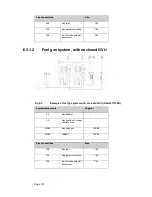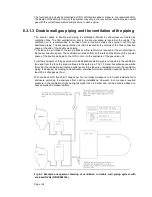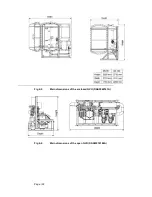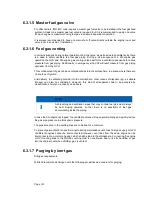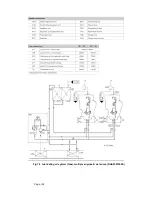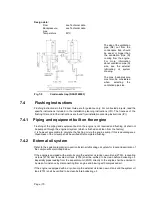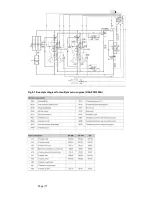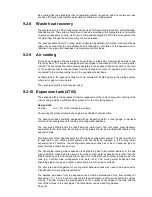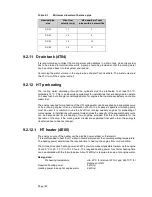
Page | 69
maximum permitted pressure is 200 kPa (2 bar) to avoid leakage through the labyrinth seal in the
turbocharger (not a problem when the engine is running). A two speed electric motor for a main or
standby pump is not accepted.
The piping shall be arranged so that the pre-lubricating oil pump fills the main oil pump, when the
main pump is engine driven.
The pre-lubricating pump should always be running, when the engine is stopped.
Depending on the foreseen oil temperature after a long stop, the suction ability of the pump and the
geometric suction height must be specially considered with regards to high viscosity.
Design data:
Capacity
see
Technical data
Max. pressure (safety valve)
350 kPa (3.5 bar)
Design temperature
100°C
Viscosity for dimensioning of the electric
500 cSt motor
7.2.5
Pressure control valve (2V03)
Design data:
Design pressure
1.0 MPa (10 bar)
Capacity
Difference between pump capacity and oil flow through engine
Design temperature
100 °C
7.2.6
Lubricating oil pump, stand-by (2P04)
The stand-by lubricating oil pump is normally of screw type and should be provided with an safety
valve.
Design data:
Capacity
see
Technical data
Design pressure, max
0.8 MPa (8 bar)
Design temperature, max.
100°C
Lubricating oil viscosity
SAE 40
Viscosity for dimensioning the electric
500 mm
2
/s (cSt) motor
7.3
Crankcase ventilation system
The purpose of the crankcase ventilation is to evacuate gases from the crankcase in order to keep
the pressure in the crankcase within acceptable limits.
Each engine must have its own vent pipe into open air. The crankcase ventilation pipes may not be
combined with other ventilation pipes, e.g. vent pipes from the system oil tank.
The diameter of the pipe shall be large enough to avoid excessive back pressure. Other possible
equipment in the piping must also be designed and dimensioned to avoid excessive flow resistance.
A condensate trap must be fitted on the vent pipe near the engine.
The connection between engine and pipe is to be flexible. It is very important that the crankcase
ventilation pipe is properly fixed to a support rigid in all directions directly after the flexible hose
from crankcase ventilation outlet, extra mass on the oil mist detector must be avoided. There should
be a fixing point on both sides of the pipe at the support. Absolutely rigid mounting between the
pipe and the support is recommended. The supporting must allow thermal expansion and ship’s
structural deflections.
Summary of Contents for 31SG
Page 1: ...Page 1 PRODUCT GUIDE W rtsil 31SG...
Page 4: ...Page 4 This page intentionally left blank...
Page 8: ...Page 8 This page intentionally left blank...
Page 14: ...Page 14 This page intentionally left blank...
Page 21: ...Page 21 This page intentionally left blank...
Page 43: ...Page 43 This page intentionally left blank...
Page 49: ...Page 49 Fig 5 1 Flexible hoses...
Page 52: ...Page 52 This page intentionally left blank...
Page 58: ...Page 58 Fig 6 4 Gas valve unit reference P I diagram DAAF051037D...
Page 60: ...Page 60 Fig 6 7 Gas valve unit P I diagram open type DAAF085795A...
Page 64: ...Page 64 Fig 7 2 Lubricating oil system single engine wet sump DAAF301501B...
Page 65: ...Page 65 Fig 7 3 Lubricating oil system Gas multiple engines wet sump DAAF301500A...
Page 72: ...Page 72 This page intentionally left blank...
Page 77: ...Page 77 Fig 9 1 Example diagram for multiple main engines DAAF301505A...
Page 87: ...Page 87 This page intentionally left blank...
Page 98: ...Page 98...
Page 109: ...Page 109 This page intentionally left blank...
Page 113: ...Page 113 This page intentionally left blank...
Page 119: ...Page 119 This page intentionally left blank...
Page 122: ...Page 122 18 4 1 Service space requirement 18 4 1 1 Service space requirement engine...
Page 124: ...Page 124 This page intentionally left blank...
Page 127: ...Page 127 This page intentionally left blank...
Page 129: ...Page 129 This page intentionally left blank...
Page 132: ...W rtsil 31SG Product Guide Page 132 21 2 Collection of drawing symbols used in drawings...

